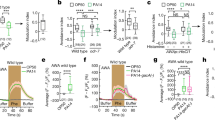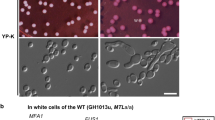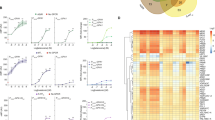Abstract
Autocrine self-signalling via secreted peptides and cognate receptors regulates cell development in eukaryotes and is conserved from protozoans to mammals1,2. In contrast, secreted peptides from higher fungi have been traditionally associated with paracrine non-self-signalling during sexual reproduction3. For example, cells of the model fungus Saccharomyces cerevisiae fall into two distinct mating types (MAT), which produce either a- or α-pheromone and the cognate receptors Ste2 or Ste3, respectively4. Inappropriate autocrine pheromone signalling (APS) during mating is prevented by downregulation of the self-pheromone receptor4,5 and by a-type cell-specific cleavage of α-pheromone through the protease Bar1 (refs. 6,7,8). While APS can be artificially induced by manipulation of the pheromone secrete-and-sense circuit7,9,10,11, its natural occurrence in ascomycete fungi has not been described. Here, we show that Fusarium oxysporum—a devastating plant pathogen that lacks a known sexual cycle12—co-expresses both pheromone–receptor pairs, resulting in autocrine regulation of developmental programmes other than mating. We found that unisexual populations of MAT1-1 cells (α-type idiomorphs13) secrete and sense both a- and α-pheromone, and that their perception requires the cognate receptors and conserved elements of the cell wall integrity mitogen-activated protein kinase cascade. We further show that F. oxysporum uses APS to regulate spore germination in a cell-density-dependent manner, whereby the α-Ste2 interaction leads to repression of conidial germination while the a-Ste3 interaction relieves repression. Our results reveal the existence of a regulatory function for peptide pheromones in the quorum-sensing-mediated control of fungal development.
This is a preview of subscription content, access via your institution
Access options
Access Nature and 54 other Nature Portfolio journals
Get Nature+, our best-value online-access subscription
$29.99 / 30 days
cancel any time
Subscribe to this journal
Receive 12 digital issues and online access to articles
$119.00 per year
only $9.92 per issue
Buy this article
- Purchase on Springer Link
- Instant access to full article PDF
Prices may be subject to local taxes which are calculated during checkout




Similar content being viewed by others
Data availability
All data that support the findings of this study are either included in this published article and its Supplementary Information files, or available from the corresponding author upon request. F. oxysporum gene data are available in GenBank under the following accession numbers: MFa (a-pheromone precursor), FOXG_18106; MFα (α-pheromone precursor), FOXG_08636; ste3, FOXG_02147; ste2, FOXG_10633; bar1, FOXG_09428; fmk1, FOXG_08140; ste12, FOXG_02103; rho1, FOXG_13835; bck1, FOXG_08078; mkk2, FOXG_02117; mpk1, FOXG_05092.
References
Doğaner, B. A., Yan, L. K. Q. & Youk, H. Autocrine signaling and quorum sensing: extreme ends of a common spectrum. Trends Cell Biol. 26, 262–271 (2016).
Vallesi, A., Giuli, G., Bradshaw, R. A. & Luporini, P. Autocrine mitogenic activity of pheromones produced by the protozoan ciliate Euplotes raikovi. Nature 376, 522–524 (1995).
Arkowitz, R. A. Chemical gradients and chemotropism in yeast. Cold Spring Harb. Perspect. Biol. 1, a001958 (2009).
Lee, S. C., Ni, M., Li, W., Shertz, C. & Heitman, J. The evolution of sex: a perspective from the fungal kingdom. Microbiol. Mol. Biol. Rev. 74, 298–340 (2010).
Herskowitz, I., Rine, J. & Strathern, J. in The Molecular and Cellular Biology of the Yeast Saccharomyces (eds Jones, E. W., Pringle, J. R. & Broach, J. R.), 583–656 (Cold Spring Harbor, 1992).
Hicks, J. B. & Herskowitz, I. Evidence for a new diffusible element of mating pheromones in yeast. Nature 260, 246–248 (1976).
Alby, K., Schaefer, D. & Bennett, R. J. Homothallic and heterothallic mating in the opportunistic pathogen Candida albicans. Nature 460, 890–893 (2009).
Ladds, G., Rasmussen, E. M., Young, T., Nielsen, O. & Davey, J. The sxa2-dependent inactivation of the P-factor mating pheromone in the fission yeast Schizosaccharomyces pombe. Mol. Microbiol. 20, 35–42 (1996).
Kitamura, K., Nakamura, T., Miki, F. & Shimoda, C. Autocrine response of Schizosaccharomyces pombe haploid cells to mating pheromones. FEMS Microbiol. Lett. 143, 41–45 (1996).
Youk, H. & Lim, W. A. Secreting and sensing the same molecule allows cells to achieve versatile social behaviors. Science 343, 1242782 (2014).
Dudin, O., Merlini, L. & Martin, S. G. Spatial focalization of pheromone/MAPK signaling triggers commitment to cell–cell fusion. Genes Dev. 30, 2226–2239 (2016).
Dean, R. et al. The top 10 fungal pathogens in molecular plant pathology. Mol. Plant Pathol. 13, 414–430 (2012).
Martin, T. et al. Tracing the origin of the fungal α1 domain places its ancestor in the HMG-box superfamily: implication for fungal mating-type evolution. PLoS ONE 5, e15199 (2010).
Yi, S. et al. Self-induction of a/a or α/α biofilms in Candida albicans is a pheromone-based paracrine system requiring switching. Eukaryot. Cell 10, 753–760 (2011).
Turra, D., Nordzieke, D., Vitale, S., El Ghalid, M. & Di Pietro, A. Hyphal chemotropism in fungal pathogenicity. Semin. Cell Dev. Biol. 57, 69–75 (2016).
Turra, D., El Ghalid, M., Rossi, F. & Di Pietro, A. Fungal pathogen uses sex pheromone receptor for chemotropic sensing of host plant signals. Nature 527, 521–524 (2015).
Kim, H. & Borkovich, K. A. A pheromone receptor gene, pre-1, is essential for mating type-specific directional growth and fusion of trichogynes and female fertility in Neurospora crassa. Mol. Microbiol. 52, 1781–1798 (2004).
Wang, Z., Kin, K., Lopez-Giraldez, F., Johannesson, H. & Townsend, J. P. Sex-specific gene expression during asexual development of Neurospora crassa. Fungal Genet. Biol. 49, 533–543 (2012).
Schmoll, M., Seibel, C., Tisch, D., Dorrer, M. & Kubicek, C. P. A novel class of peptide pheromone precursors in ascomycetous fungi. Mol. Microbiol. 77, 1483–1501 (2010).
Vitale, S. et al. Structure–activity relationship of α mating pheromone from the fungal pathogen Fusarium oxysporum. J. Biol. Chem. 292, 3591–3602 (2017).
Chitarra, G. S., Abee, T., Rombouts, F. M., Posthumus, M. A. & Dijksterhuis, J. Germination of Penicillium paneum conidia is regulated by 1-octen-3-ol, a volatile self-inhibitor. Appl. Environ. Microbiol. 70, 2823–2829 (2004).
Herrero-Garcia, E., Garzia, A., Cordobés, S., Espeso, E. A. & Ugalde, U. 8-Carbon oxylipins inhibit germination and growth, and stimulate aerial conidiation in Aspergillus nidulans. Fungal Biol. 115, 393–400 (2011).
Di Pietro, A. et al. Endopolygalacturonase PG1 in different formae speciales of Fusarium oxysporum. Appl. Environ. Microbiol. 64, 1967–1971 (1998).
Lopez-Berges, M. S., Rispail, N., Prados-Rosales, R. C. & Di Pietro, A. A nitrogen response pathway regulates virulence functions in Fusarium oxysporum via the protein kinase TOR and the bZIP protein MeaB. Plant Cell 22, 2459–2475 (2010).
Di Pietro, A. & Roncero, M. I. Purification and characterization of an exo-polygalacturonase from the tomato vascular wilt pathogen Fusarium oxysporum f.sp. lycopersici. FEMS Microbiol. Lett. 145, 295–299 (1996).
Puhalla, J. E. Compatibility reactions on solid medium and interstrain inhibition in Ustilago maydis. Genetics 60, 461–474 (1968).
Schindelin, J. et al. Fiji: an open-source platform for biological-image analysis. Nat. Methods 9, 676–682 (2012).
Sage, D. et al. DeconvolutionLab2: an open-source software for deconvolution microscopy. Methods 115, 28–41 (2017).
Sievers, F. et al. Fast, scalable generation of high-quality protein multiple sequence alignments using Clustal Omega. Mol. Syst. Biol. 7, 539 (2011).
Tamura, K. et al. MEGA5: molecular evolutionary genetics analysis using maximum likelihood, evolutionary distance, and maximum parsimony methods. Mol. Biol. Evol. 28, 2731–2739 (2011).
Tusnady, G. E. & Simon, I. The HMMTOP transmembrane topology prediction server. Bioinformatics 17, 849–850 (2001).
Spyropoulos, I. C., Liakopoulos, T. D., Bagos, P. G. & Hamodrakas, S. J. TMRPres2D: high quality visual representation of transmembrane protein models. Bioinformatics 20, 3258–3260 (2004).
Bailey, T. L. & Elkan, C. Fitting a mixture model by expectation maximization to discover motifs in biopolymers. Proc. Int. Conf. Intell. Syst. Mol. Biol. 2, 28–36 (1994).
Acknowledgements
We thank the members of the Di Pietro laboratory for helpful comments on the manuscript, and E. Martínez Aguilera for valuable technical assistance. This work was supported by grant BIO2016-78923-R from the Spanish Ministerio de Economía y Competitividad to A.D.P. S.V. was supported by the Marie Curie ITN FungiBrain (FP7-PEOPLE-ITN-607963).
Author information
Authors and Affiliations
Contributions
S.V., D.T. and A.D.P. designed the experiments. S.V. and D.T. carried out the experiments. S.V. and D.T. analysed the data. S.V., A.D.P. and D.T. wrote the manuscript.
Corresponding author
Ethics declarations
Competing interests
The authors declare no competing interests.
Additional information
Publisher’s note: Springer Nature remains neutral with regard to jurisdictional claims in published maps and institutional affiliations.
Supplementary information
Supplementary Information
Supplementary Figs. 1–12, Table 3 and references.
Supplementary Table 1
Complete list of P values for all statistical analyses.
Supplementary Table 2
Oligonucleotide primers used in this study.
Rights and permissions
About this article
Cite this article
Vitale, S., Di Pietro, A. & Turrà, D. Autocrine pheromone signalling regulates community behaviour in the fungal pathogen Fusarium oxysporum. Nat Microbiol 4, 1443–1449 (2019). https://doi.org/10.1038/s41564-019-0456-z
Received:
Accepted:
Published:
Issue Date:
DOI: https://doi.org/10.1038/s41564-019-0456-z
This article is cited by
-
Enhancing tomato resistance by exploring early defense events against Fusarium wilt disease
Phytopathology Research (2023)
-
Structure and number of mating pheromone genes is closely linked to sexual reproductive strategy in Huntiella
BMC Genomics (2023)
-
ASF1 regulates asexual and sexual reproduction in Stemphylium eturmiunum by DJ-1 stimulation of the PI3K/AKT signaling pathway
Fungal Diversity (2023)
-
The role of vegetative cell fusions in the development and asexual reproduction of the wheat fungal pathogen Zymoseptoria tritici
BMC Biology (2020)
-
A bacterial endophyte exploits chemotropism of a fungal pathogen for plant colonization
Nature Communications (2020)



